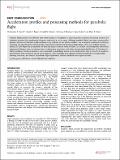Acceleration profiles and processing methods for parabolic flight
Author(s)
Ruvkun, Gary; Bryan, Noelle C.; Saboda, Kendall Nicole; Bhattaru, Srinivasa Aditya; Zuber, Maria; Carr, Christopher E.; ... Show more Show less
Downloads41526-018-0050-3.pdf (921.2Kb)
PUBLISHER_CC
Publisher with Creative Commons License
Creative Commons Attribution
Terms of use
Metadata
Show full item recordAbstract
Parabolic flights provide cost-effective, time-limited access to “weightless” or reduced gravity conditions, facilitating research and validation activities that complement infrequent and costly access to space. Although parabolic flights have been conducted for decades, reference acceleration profiles and processing methods are not widely available. Here we present a solution for collecting, analyzing, and classifying the altered gravity environments experienced during parabolic flights, which we validated during a Boeing 727-200F flight with 20 parabolas. All data and analysis code are freely available. Our solution can be integrated with diverse experimental designs, does not depend upon accelerometer orientation, and allows unsupervised classification of all phases of flight, providing a consistent and open-source approach to quantifying gravito-inertial accelerations (GIA), or g levels. As academic, governmental, and commercial use of space advances, data availability and validated processing methods will enable better planning, execution, and analysis of parabolic flight experiments, and thus facilitate future space activities.
Date issued
2018-08Department
Massachusetts Institute of Technology. Department of Aeronautics and Astronautics; Massachusetts Institute of Technology. Department of Earth, Atmospheric, and Planetary SciencesJournal
npj Microgravity
Publisher
Springer International Publishing
Citation
Carr, Christopher E., et al. “Acceleration Profiles and Processing Methods for Parabolic Flight.” Npj Microgravity, vol. 4, no. 1, Dec. 2018. © 2018 The Authors
Version: Final published version
ISSN
2373-8065